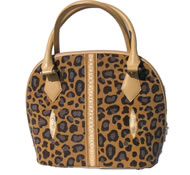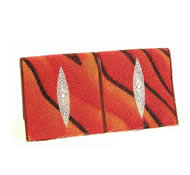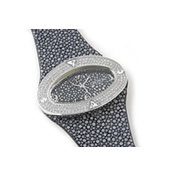Stingray leather

Stingray out for a meal
I remember the Corvette Stingray. It's a very fast and fancy car back then. Okay, we're talking about the stingray, the fish, not the car.
Stingrays are basically bottom feeders; feeding at the bottom of the sea. And they like to live where the water is warm. That's why you'll find most of them in tropical waters.
The leather is something very remarkable. We had personal experience seeing and handling two types of stingray hide. The one that has gone through the tanning process before being dyed/polished and the other ready for making leather products. The raw leather hide has this small pebble like things on the surface and along the middle there are sharp spines. They felt hard like high-grade plastic and are sharp. What's remarkable is that it occurs naturally! The polished leather is, ... beautiful. Really very beautiful.
Stuff to Know
Animal: |
Stingray Fish (Dasyatis Bleekeri) |
Maximum size & weight: |
The recorded maximum length is 300 cm. Maximum weight unknown. |
Maximum age: |
25 Years |
Protected? |
No, stingray is not an endangered species. |
Where it lives in the wild |
Indochina (from Myanmar to Philiphines), Indonesia, Japan, China, India |
Where is it farmed? |
It's not farmed. Caught in the wild only. |
Dangerous to humans? |
Generally not, unless stepped on. Then their tail injects a highly painfull toxin into your leg. The shooting pain will remain for the next hours, and then give away, though you will still feel it for the next two days. It (almost) never kills a human. |
Afraid of humans? |
Not much, but they will rather swim away than let you touch them |
People injured yearly |
Cases of injury are very rare. We have no available information. |
People killed yearly
by |
It is somewhat unlikely that a person will get killed by a stingray. |
Is meat edible? |
Yes. Stingray are couught for they meat, and leather is only a by-product |
Taste of meat |
Very good. It's a delicacy served in many fancy restaurants across Asia. |
Living habits: |
They live in shallow, tropical waters, usually keeping to the bottom parts. You are likely to find them lying on a seabed. They are often burried and covered with sand with only their eyes visible. They can move very rapidly when threatened or in pursuit of a passing fish. They usually live "alone". |
Eating habits: |
They eat squid, fish and crabs. They can't see their prey (their eyes are on the top) so they depend on electroreceptors and their keen senses of smell and touch. |
Farming style: |
They are catched only in the wild, not farmed. |
Harversting weight
and size: |
There are no specifics of the catch on stingray, so suffice to say, it varies from catch to catch. |
Skin processing: |
The flesh is removed. Then it is washed from blood, dirt, etc. Then it goes through the same tanning process similar to fish leather. |
Leather durability: |
The natural color is dark green, very durable. |
Leather softness: |
Not soft; hard and tough |
Other Leather features: |
It has small pebble-like objects, the spine is polished and dyed to give accent. |
Leather relative
value (1-10) in finished products. |
10 |



